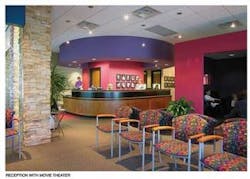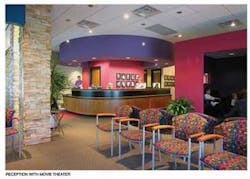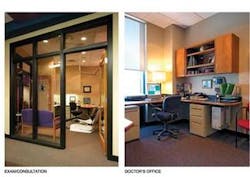The power of design to enhance your practice: How to avoid errors and build in success
by Dr. Michael Unthank
For more on this topic, go to www.dentaleconomics.com and search using the following key words: design program, office design, office “identity,” first impression, functional space, “zone,” avoid design errors, Dr. Michael Unthank, Focus On.
Your office environment is the ultimate reflection of your skills as a dentist and the professionalism of your team. Take a look around your office. What does it say about your practice?
Is the reception area a welcome oasis for busy patients, or just the “queue” for the day? Does the hallway provide easy access to and from treatment rooms, or is it a pinball alley where you have to dodge patients and staff? Does your treatment area lock you into performing specific procedures in specific rooms (as in the “doctor's favorite room”), or is it designed to allow more efficient scheduling?
A well-planned dental office will have an immediate and positive impact on virtually all facets of your practice. It can improve your productivity while decreasing your stress. It will allow you to create an “identity” consistent with the type of practice you enjoy or wish to develop. It will communicate the quality of your services, inspire your patients' confidence, and assure their comfort. It has been said, “You only have one chance to make a good first impression.” For your patients, your dental office is it.
Two critical planning steps
Before planning a new office layout, take these two critical steps in order to save dozens of missteps in design:
1 Remind yourself each day that you are a dentist, not an architect. Choose a team of qualified professionals to assist you in realizing your dream. You want experts who have designed dental offices and are intimately familiar with the challenges of running a dental practice. Although yours is the final word when it comes to decisions, a qualified design team will save you from making a string of bank-busting mistakes. 2 Develop your design program — the “treatment plan” for your ideal office. The design program identifies what you do and do not want in your new facility. It's an exhaustive list of practice needs, desires, and goals, and essentially defines “how you intend to practice.” Your design program clearly spells out office functions and the essential elements for ensuring those functions are carried out effectively — from greeting patients and managing the schedule, to diagnosing, treatment planning, case presentations, collections and financial arrangements, and delivering treatment. Your design program forms the written foundation from which your office design will be developed.Avoid repeating design flaws
Many dentists who want to improve their workspaces are surprised by the magnitude of the project to which they commit themselves and their checkbooks. Despite this major outlay of time and money, they often envision their new practice as a carbon copy of their existing facility, only bigger. Just transferring problem areas does nothing to address the key stressors and function flaws that trip up the team.
Chances are pretty good you'll only build a new office once, so be sure to avoid building the same traps you want to escape. Approach each functional space — or “zone” — with a fresh perspective. Effective zones take into consideration numerous elements, from equipment and ergonomic function, to privacy, lighting, and technology.
Remember, it costs more to build your office wrong than it does to build it right, since over the life of an improperly designed office space your practice will suffer from functional inefficiencies and increased stress.
Blending form and function
Ultimately, your office should blend form and function. The goal of successful office planning is being able to finish each day with more money in your pocket, less stress in your life, and everyone looking forward to returning the next morning. Dental offices must satisfy a range of diverse needs. They must be welcoming, yet clinically functional, and they must exude professionalism, yet not appear ostentatious. They must achieve all this on a budget that makes sound financial sense.
Give yourself time to make the decisions that will impact your practice positively for the rest of your practice life. From the onset of planning, be sure everything will work the way you want. If it does, you may never have to build again. If it doesn't, your costly errors could negatively affect your practice's efficiency and the morale of your office team.
Tips for ensuring an effective design
Follow the tips offered below to ensure that your new office space works effectively for you, your staff, and your patients:
- Create a reception area that enables the receptionist to turn 90 degrees to welcome the patient, and 90 degrees away from the patient to conduct other business. This ensures that patient conversations and payment transactions remain private.
- Position treatment areas so that they are not visible from the public areas such as the greeting and reception areas.
- Designate private office and break room space away from the patient activity areas.
- Equip all treatment rooms identically so every room is the “doctor's favorite room.”
- Integrate technology in treatment areas for practice management, education, treatment co-diagnosis, and if desired, entertainment during procedures.
- Allow for future technology growth and expansion.
- Before you build, take a seminar on office planning and design.
Reflecting quality of care
Your physical facility is a testament to the care provided within. Patients assess the quality of your services on numerous factors, not the least of which is the physical image the practice projects.
If the space is worn, tattered, cluttered, and poorly organized, patients may transfer that perception to the quality of the services provided.
By building effective design into your practice, you will take a significant step in communicating to your patients that they will receive the highest quality of care.
Dr. Michael Unthank, a registered professional architect, owns Unthank Design Group, a planning architecture and interior design firm that provides services exclusively to the dental professions. Dr. Unthank conducts seminars nationwide, and is a featured speaker at major dental meetings. He can be reached at (402) 423-3300, [email protected], or www.unthank.com.


